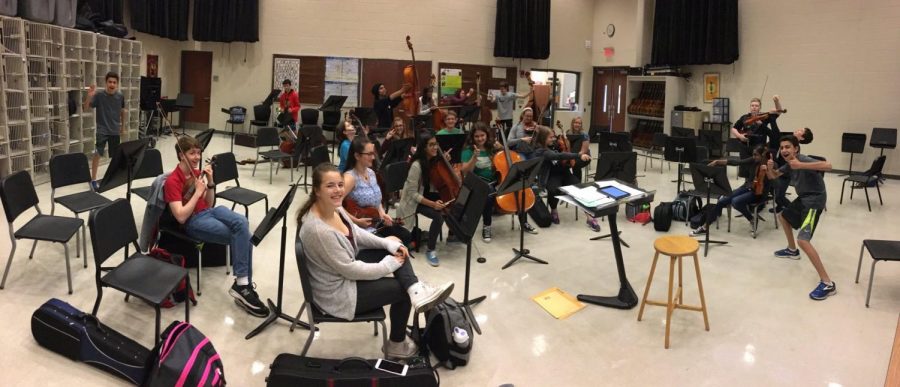Bear Strings modernizes orchestra
A new take on typical genres
String instruments are not restricted to classical music. In fact, musicals such as La La Land and Hamilton are present in Bear Strings, an orchestral ensemble that performs nontraditional music pieces.
Bear Strings, originally called Chamber Strings, is the ideal ensemble for students in the orchestra program who want play new things and experiment, according to Nathan Sackschewsky, orchestra conductor and sponsor of Bear Strings. Typical orchestral pieces revolve around composers such as Beethoven and Mozart. However, according to Sackschewsky, Bear Strings is all about flexibility and freeform.
“I usually say it’s our alternative-style string ensemble, which kind of just means that it’s the group that plays nontraditional orchestral music pieces,” Sackschewsky said. “We cover all sorts of genres from movie music to jazz tunes to fiddle tunes to pop charts, just whatever we want to play.”
Not only does Bear Strings differentiate itself from other orchestras by style and genre, but it is also a student driven organization, according to Sackschewsky. Normally, in orchestra ensembles such as Sinfonietta, the conductor selects music, leads practice, and is the main influencer, according to Emma Mural, freshman and member of Bear Strings. However in Bear Strings, the ensemble is “what students bring to it,” Sackschewsky said.
“Whatever their interests are or wherever they wanna go, it’s totally much more freeform. We have that flexibility and those options. Sometimes I bring some pieces, sometimes we get some recommendations. That’s why we did seven nation army, because a couple students really wanted to do it,” Sackschewsky said. “Some holiday tunes that we do for blue notes or bare voices concerts really come straight from students as well.”
Additionally, Bear Strings lacks the competitive factor that the majority of other orchestras possess, according to Mural. It consists of about half of those in Concert Orchestra, the non-audition program, and Symphony Orchestra, the audition-required program, said Sackschewsky.
“It’s non-audition, so anyone in the whole orchestra program can do it. And people can kind of come and go as they want,” Sackschewsky said.
If members have activities such as sports or other commitments, they are free to only attend practices leading up to one of the three year-round concerts, according to Sackschewsky. Bear Strings is also the only ensemble that meets after school.
“We meet once a week, four times a month,” Mural said. “A typical practice means we get about 2-3 minutes to tune, get our music out, and get seated. Then about 35 minutes of playing, a 5 minute break and then more playing until 4:30 when it ends,”
According to Sackschewsky, Bear Strings is always looking to welcome new members.
“Bear Strings is a very casual, fun environment. Everyone I’ve met has been awesome, and we get to play really cool music such as jazz tunes and fiddle tunes,” Mural said. “I definitely enjoy going and playing for Bear Strings. It provides me with a fun way to challenge myself as a violinist because there isn’t really another ensemble like Bear Strings. And that in itself motivates me to continue with it.”

